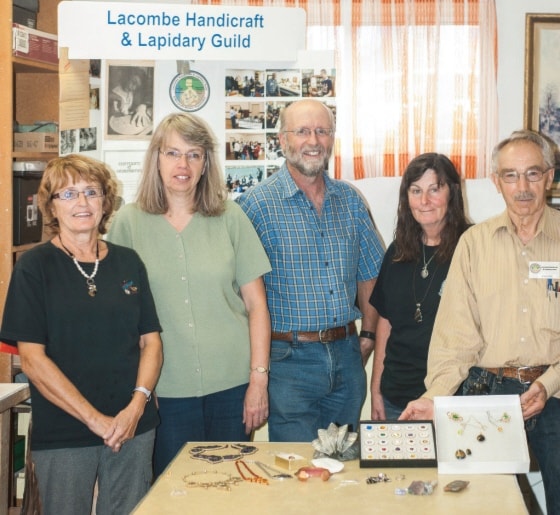If you like crafts or rocks, there may be a place for you in the Lacombe Handicraft and Lapidary Guild.
Lapidary can be defined as the act of forming stones, gems or minerals into a myriad of different decorative items. Or, as guild member Carolyn Cave puts it, a hobby involving a bit of geology.
“We work with rocks,” said Cave.
Members of the lapidary guild include rock collectors, rock tumblers, polishers, cutters and everything in between, said Cave.
She added that many of them choose to expand what they do with rocks and gemstones and incorporate silversmithing and other such craft skills into their hobby.
Lacombe’s lapidary guild is all about sharing knowledge. As such, many of its members also teach classes on different aspects of the art form.
For example, Ron Biel, secretary of the guild, has taken courses at Alberta College of Art and Design (ACAD) on gem setting and production techniques like casting.
Biel has also taken some training in fold forming, the newest jewelry making technique in the world, where metal is forged, repeatedly folded and then unfolded to take an entirely new form.
Fold-forming was discovered by an instructor at ACAD so is native to Alberta.
Dave Biro, one of the most senior members of the guild, teaches gem faceting, the technique of cutting a gemstone in order to make the different faces of a gem that make it sparkle when it catches light. The term facet also implies that there is more than one flat surface on a stone or gem.
Every Wednesday, the Lacombe Handicraft and Lapidary Guild meets in the basement of the Kozy Korner for its weekly workshop.
Biro said that the object of the guild and its workshops is to learn by practicing.
“Our main focus is hands-on,” said Biro.
In their small workshop in the basement of the Kozy Korner, the guild has a number of machines as well as other supplies and equipment for all the different skills used by guild members with their rocks and gems.
Anyone can take the process of lapidary as far as they want, all the way to jewelry making or just sticking with the simpler techniques like cutting and polishing stones. Generally, guild members start as rock collectors, also known as ‘rockhounds’ and grow to practice more techniques.
Typically, the process of taking a stone to a finished product begins like this. First, a slab of rock is marked with the desired shapes which are then cut out.
Next, a dop stick is made where a rough cut stone is attached to a stick with wax. The dop stick gives the worker something to hang onto while grinding and polishing the stones.
Stones are ground and polished using a series of diamond polishing stone wheels that work basically like sandpaper. Each stone has a different grit, from very rough to very fine.
Once the polishing is finished, an artist can decide what to do with the finished piece, whether to use it with beading, use silversmithing to fashion it into some kind of jewelry, or whatever else the artist might like.
For gemstones, the process is somewhat different. Instead of grinding and polishing the rock to create one smooth rounded surface like a cabochon, the rock is held at specific angles while grinding to create the different sides so that the light will shine through it, which is what makes gems shine.
Biro added that most people who get serious about faceting buy a special machine designed to cut those angles. He said this gives artists more control over the cutting. Unfortunately, Alberta does not have an abundance of native gems and precious stones.
Biro said most lapidary members buy their stones from gem and mineral shops. However, some members have done traveling and brought back rocks from all over the world to work with.
Each of the artists has their own focus or specialty with lapidary that they prefer to work with. Cave said that all the areas are related, but some members focus on them more than others.
“I think it would be fair to say that each one of us has an area that we like the most,” said Cave.
For example, she added that she gravitates towards doing beadwork with stones while Biro prefers faceting.
Guild member Trish Duckett said taking a stone through this process is one of the things she enjoys about being part of the Lacombe Handicraft and Lapidary Guild. She added she also likes learning a little more about geology.
“You learn a lot about your rocks and your gems,” said Duckett. “It’s kind of cool to take a raw stone and cut and polish it and make something really cool out of it.”
The Lacombe Handicraft and Lapidary Guild was formed in March of 1980 and used to have close to 60 members. Unfortunately, its numbers have dwindled and now there are only about 15 active members.
But, the club is always accepting new members and is open to anyone 10 years of age and up.
Biro said that lapidary is a hobby that many people can follow throughout their lives, even well into old age.
